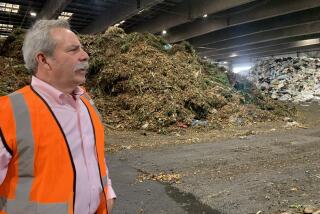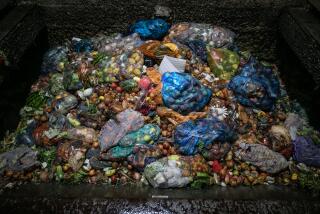Disassembly Lines Hum in Japan’s New Industry
- Share via
TOKYO — Takeshi Sugino, a designer for the Mitsubishi Group, has spent 29 years thinking about how to create better machines for people’s laundry. Several years ago, though, he and two colleagues were taken to a large concrete room near Osaka and told to smash, tear and otherwise destroy the 200 washing machines inside.
“It was very hard work,” Sugino says. “They were old and dirty, with lots of bugs inside. The only fun part was finding change that had fallen out of people’s pockets.”
The lessons that Sugino learned from that experience are paying dividends now, however, because last month, Japan enacted the toughest appliance recycling law in Asia. About 18 million washing machines, televisions, refrigerators and air conditioners junked annually in this nation famous for mass production and planned obsolescence face mandatory recycling, with consumers footing much of the bill.
Used appliances are only a small part of Japan’s bigger waste problem, accounting for just 1.3% of the 50 million tons this nation produces annually. New laws also require that food and office computers be recycled this year, home computers and building industry waste next year and autos at some point further out. But appliances take up lots of space and are difficult to break down.
That’s where Sugino’s bash-a-thon comes in. Wrestling with washing machines of every imaginable style, size and shape over a four-day period made him appreciate how difficult it was to pull them apart. Spin buckets were attached to motors with giant bolts that would challenge King Kong. And finding all the hidden screws was often like playing “Where’s Waldo?”
Taking those lessons to heart, Sugino helped design Mitsubishi’s 2001 model using small standard-size bolts, in easy-to-find places, that can be quickly removed with ordinary tools. Symbols printed inside the washer provide a road map of the number and location of screws. And breakaway parts allow the entire outer casing to be pulled off with the removal of just two screws, producing a savings of at least 10 seconds from the time it would take on an older model.
“Ten seconds may not seem like a lot. But when you’re taking thousands of these things apart, it really adds up,” Sugino says.
Japan is aggressively tackling its mountain of junk appliances for a simple reason: It doesn’t have much choice. With 126 million people jammed into a mountainous country roughly the size of California, it has only a couple of years’ worth of dump space left.
“Our landfills are at the end of their lives,” says Eiji Hosoda, an economics professor and noted waste expert at Keio University.
A Debate Over Costs
But behind the five-year effort to enact the new law was a huge debate over whether to have consumers share the cost of recycling when they purchase an appliance, as in several European countries, or when the time comes to dump it. Given the 300 million appliances already in use, lawmakers decided to hit people at the end.
And that has led to considerable resentment here, as consumers used to disposing of appliances at no cost are suddenly whacked with disposal bills ranging from about $60 for a refrigerator to $35 for a washing machine, including transportation.
“From almost nothing to suddenly having to pay $40 or more is really quite a shock,” says Kyoko Otake, a 72-year-old Tokyo housewife. “It’s difficult to understand how they can justify this.”
In fact, despite the Japanese reputation for politeness, Tokyo Eco Recycling--one of 380 appliance recycling centers now set up nationwide--has answered its phone several times in recent weeks to hear people shrieking about the high charges.
“Even my wife complains she has to pay so much,” admits Masayuki Yamamoto, manager of the plant, which is owned jointly by Hitachi and a local waste company.
The $15-million Tokyo Eco facility, built near Tokyo Bay on a landfill, is a state-of-the-art recycling factory. But given the range of models it must handle, it’s still pretty low-tech and labor-intensive, especially compared with the robot-equipped plants churning out Japan’s dizzying array of new models.
Just inside the loading area, a large green beast of a refrigerator is knocked on its side by workers who then strip it by hand of its Freon, door insulation and motor. Despite the Japanese penchant for cleanliness, employees find their share of rude surprises in such castoffs, including rotten fish and dead pets.
Once appliances are stripped of their readily usable parts, they head up a conveyor belt to appliance heaven--a giant crusher that reduces them to inch-square bits of metal and plastic. These are then separated and graded by a series of magnets, blowers, filters and spinners.
The factory hopes eventually to handle 600,000 appliances a year. But meanwhile, there is widespread confusion in the country about how the new recycling system works. Consumers can return their old appliances to retailers, some local governments or private hauling companies. Transport charges and local rules vary widely.
“A lot of people are a bit bewildered,” says Toshiaki Nagato, head of the Environment Ministry’s recycling section.
A Rush to Avoid Fees
In the weeks immediately before the April deadline, in fact, consumers rushed to dump their old appliances and avoid the high fees. Now local governments are bracing for an expected wave of illegal dumping, particularly in areas abutting big cities, as city slickers try to pull a fast one on their less crowded neighbors.
“All these people from Tokyo [and neighboring] Chiba and Saitama dump on us, and we’re getting tired of it,” says Seichi Midorikawa, a Shirakawa municipal officer. “In a few cases, we find bills or test scores inside the appliances and can track [the owners] down. But most of the time, we’re stuck.”
Some local governments are setting up garbage patrols. Masaru Takahashi spends several hours a day cruising in a vehicle equipped with a camera, mobile phone and walkie-talkie, trying to catch illegal dumpers in the act.
Tochigi prefecture hopes satellite imagery, global positioning equipment and camera-equipped personal digital diaries will catch scofflaws in the act. And the city of Nara is using “high-tech scarecrows” that shine lights and issue verbal warnings when activated by infrared sensor equipment.
Planners also hope Japan’s size and dense population will help curtail illegal dumping.
“It’s not always that easy to dispose of a fridge illegally in Japan, since it’ll probably cost you $20 to $30 in gas anyway just to take it to the mountains,” says Toshiaki Nagato, head of the Environmental Ministry’s recycling promotion office.
Some environmentalists and citizens groups say the new law puts too much burden on consumers and too little on companies.
“The law should have been much tougher,” says Ayako Sekine, a campaigner with Greenpeace Japan. “They just didn’t want to burden industry.”
All the same, manufacturers are bearing a good share of the burden. The money they receive from consumers to recycle old appliances covers only part of their costs, at least until they become more efficient. According to one study by the Tokyo government, recycling a refrigerator actually costs closer to $125, more than twice what companies collect.
Under the law, the companies must recycle 50% to 65% of the appliances by weight. Many of the decade-old machines now being recycled contain quite a bit of metal, which is relatively easy to sell to scrap dealers for eventual use in shiny new Toyotas and Hondas. Later models have more plastic, however, putting pressure on companies to find cost-effective ways to reuse polymers. Now, most plastic waste is fed into municipal dumps.
Critics of the new law also argue that Japan’s entire approach to the environment is misdirected and that much more effort should go into extending the life cycle of products rather than into disposal and recycling. That’s a step companies resist, although the government claims to be working on it.
“Manufacturers make new models every year, they don’t keep parts, and you’re always expected to buy a new one,” says Hisako Izuka, a 54-year old housewife in Tokyo. “Repairing appliances would be a much better way of helping the environment.”
Ultimately, behind the move to apportion more of the cost of pollution among those responsible for polluting is a bid to change the way Japanese view waste.
This, after all, is a country famous for its lavish wrapping of even mundane products, for manufacturing forests’ worth of disposable chopsticks and for throwing away items even slightly dirty or used.
Still, many aspects of so-called Japanese culture are only 30 or 40 years old, says Keio University’s Hosoda, and will respond to economic incentives. One study found that virtually all Japanese took supermarket plastic bags if they were free but that only 30% took bags if they cost 4 cents apiece and just 8% if the price was 8 cents.
“During my mother’s time, people used to use their own bags,” Hosoda says. “Culture can change.”
*
Rie Sasaki of The Times’ Tokyo Bureau contributed to this report.
More to Read
Inside the business of entertainment
The Wide Shot brings you news, analysis and insights on everything from streaming wars to production — and what it all means for the future.
You may occasionally receive promotional content from the Los Angeles Times.










